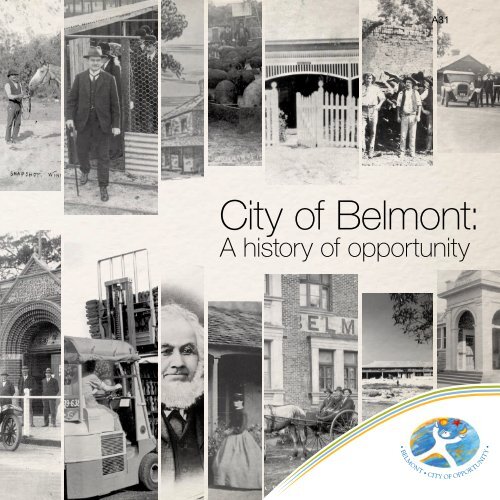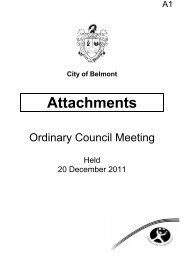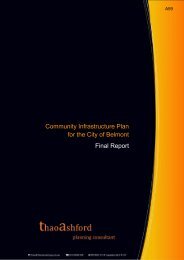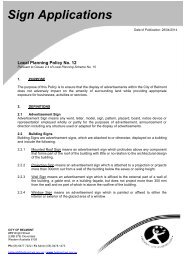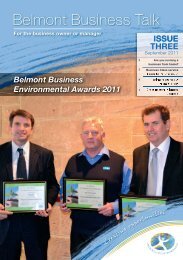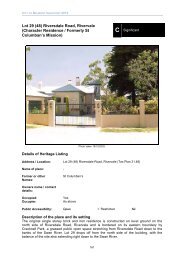City of Belmont: A History of Opportunity
City of Belmont: A History of Opportunity
City of Belmont: A History of Opportunity
Create successful ePaper yourself
Turn your PDF publications into a flip-book with our unique Google optimized e-Paper software.
A34Jane Eliza Currie, Panorama <strong>of</strong> the Swan River SettlemenGrove FarmLocation, location, locationFew colonists knew the risk they were taking.Dumped on Garden Island at the start <strong>of</strong> a greywinter in 1829, they discovered that land remainedunallocated, there were no buildings and nonegotiations with the Noongar people.The <strong>Belmont</strong> district was so popular, because <strong>of</strong>its river frontage, Governor Stirling was forced tomake each block long and narrow so everyonehad access to the water.Location 34 was assigned to Francis Byrne, whichhe promptly called ‘<strong>Belmont</strong> Estate’. When Byrnesold up in 1835, he had built two cottages on hisland, and he noted that its many jarrah trees couldbe conveyed easily by river to Perth or Guildford.Mark Currie was appointed to survey and allocatethe parcels <strong>of</strong> land. He spent the first few weeksconducting a survey <strong>of</strong> the Swan River, managingto reserve ‘Swan Location 28’ for himself.The Curries’ called their property Red Cliff afterthe steep red clay banks <strong>of</strong> the Swan River, claywhich was later to be used to make bricks.James Drummond was the owner <strong>of</strong> Location32, moving to the colony with Jane and theirchildren. Drummond was a botanist and keenplant collector, whose pockets, bag and hatwere always stuffed with specimens.Understandably, he was appointed GovernmentNaturalist. A post for which he received no pay.LOCATION DATE NOTABLE OWNERS NAME OF ESTATELocation 28 1829 Mark John Currie1,000 ha 1834 George WilliamsRed CliffLocation 29 1830s George Williams400 ha1839 R. W. NashGolden Grove Farm1830 Joshua GregoryLocation 301832 James Drummond400 ha1878 Robert Davey Hardey1829 William GellibrandLocation 311830 Joshua Gregory400 ha1831 James Drummond1878 Robert Davey HardeyLocation 32400 ha18291878James DrummondRobert Davey HardeyLocation 33800 ha18291829James HentyPhilip DodGrove Farm1835 John Wall Hardey1830 Captain F. ByrneLocation 341835 J. P. Beete930 ha1854 John Wall Hardey<strong>Belmont</strong> FarmFIRE AT RED CLIFF (1833)On Saturday last, a valuable building, the property <strong>of</strong> Captain Currie, R.N.,was destroyed by a bush-fire. Lieut. McLeod was on the spot, but too late torender any further assistance than merely by clearing away the palings whichsurrounded the house. A large gum-tree overhung the premises; this caughtfire, the flames reaching the thatch, the whole was instantly in a blaze, leavingmerely the bare brick-walls.4
A35A thoroughlypractical manBrothers John and Joseph Hardey arrived in Western Australia aboardthe Tranby in 1830. Over the next few decades, John and his son,Robert Davey, were to acquire most <strong>of</strong> the land in the <strong>Belmont</strong> district.Soon after arriving, John and Joseph were each given 40 hectares <strong>of</strong> landon the Maylands Peninsula. The brothers both built homes on the Peninsulaand started the farms which soon made them celebrated in the colony.Joseph called his home Tranby House.John’s second acquisition was land situated opposite his farm on thePeninsula. Buying the block from Phillip Dod, John named it Grove Farmin 1835. However, he does not appear to have lived there until 1843, whenhe returned from time spent farming at York. To extend his holdings, Johnbought the adjoining <strong>Belmont</strong> Farm in 1854.All <strong>of</strong> this land was inherited by John’s only son, Robert Hardey, who kept uphis father’s practice by purchasing additional blocks. In all, Robert becamethe owner <strong>of</strong> five large locations covering an immense area.In 1880, Robert built his family a spacious home, <strong>Belmont</strong> House. This hadeleven rooms, along with a coach house, stable, large garden, orchard, andtwo small paddocks. After his father died in 1885, Robert was keen to returnto the family homestead at Grove Farm, so he <strong>of</strong>fered <strong>Belmont</strong> House for rent.John Wall HardeyFrom J. W. Hardey’s obituaryAs a settler, he was a thoroughly practical man, and bestowedmuch attention upon stock-breeding, wheat-growing, andviticulture. For several years Mr Hardey occupied a seat inthe Legislative Council with much credit, while as writer inthe public journals, he displayed considerable power. Hebelonged to the Wesleyan Church, but for many years afterhis arrival he did not take any very active part.Hardey and family at home5
A381829 Beginning <strong>of</strong> the SwanRiver Colony with the arrival <strong>of</strong>the Parmelia, carrying GovernorJames Stirling and the first settlers.1860s Convict camp establishedat Depot Hill, Redcliffe, for buildinglocal roads. Slices <strong>of</strong> jarrah cut toconstruct the Great Eastern Highway.1870 W. H. Strickland becomeschair <strong>of</strong> Western Australian TurfClub (founded 1852), introducingpr<strong>of</strong>essional trainers and jockeys.1880 <strong>Belmont</strong> House built forRobert Davy Hardey, later turnedinto Sandringham Hotel.1896 Sugar’s Brickworks founded.1830 Prominent in <strong>Belmont</strong>’sdevelopment, John Wall Hardeyarrives on the Tranby.Colonists divide up river frontage.Mark Currie and James Drummondbecome <strong>Belmont</strong>’s first landholders.Currie calls his place Red Cliff afterthe river’s clay banks.Growth in <strong>Belmont</strong> area slow, withmost farms just a house with littlecleared land.1833 Red Cliff destroyed by fire.Only bare brick walls remained.First calls for a causeway acrossthe mudflats, to better connectFremantle, Perth and Guildford.1834 Capt. Byrne markets <strong>Belmont</strong>Farm as having two cottages andbeing good for timber.1835 John Wall Hardey buysGrove Farm, but leases it totenants until 1843.1837 Conflict, but no injuries,between traditional owners andoccupants <strong>of</strong> Redcliff Farm.1843 John Wall Hardey movesfrom York to Grove Farm in <strong>Belmont</strong>.With the Causeway completed anda bridge across the Helena River,the track through <strong>Belmont</strong> becomesa key route.1847 The first murder <strong>of</strong> onecolonist by another takes placeat Rivervale.1848 First race meeting held atGrove Farm, followed by pickinga site on Hardey’s property for PerthRacecourse (now called Ascot).1887 First Prince wins the inauguralPerth Cup by two lengths, collecting£250.1892 Gold rush brings people,who need housing. Brickworks usethe clay by the river. Poultry farms,dairies and piggeries also spring up,along with Chinese market gardens.1893 Racecourse Hotel built byGeorge Towton (demolished 1933).1895 Subdivision <strong>of</strong> AscotGarden Estate.First <strong>Belmont</strong> Hall constructed.1897 Disappointing subdivisions<strong>of</strong> <strong>Belmont</strong> and Redcliffe Estates.Construction <strong>of</strong> Ascot Inn, whichchanged its name to <strong>Belmont</strong>Hotel in 1916.Opening <strong>of</strong> <strong>Belmont</strong> School in theold hall, which turns out to be anunsuitable venue.Opening <strong>of</strong> new grandstand at theRacecourse, which will be servicedby two railway bridges over the riverand a new station.1898 Construction <strong>of</strong> <strong>Belmont</strong>Primary School.1899 First elections for the new<strong>Belmont</strong> Road Board.1800 – 1850 1850 – 1900
A391901 <strong>Belmont</strong> House convertedinto Sandringham Hotel.1902 New <strong>Belmont</strong> Hall constructed.1904 Invercloy (later known asNulsen Haven) built in Redcliffe forJohn Wilkie.Kirton’s Patent Pottery Co.,<strong>Belmont</strong>’s first such factory,opens on Grandstand Road.1905 Horse-drawn bus servicebetween <strong>Belmont</strong> and Perth,which was replaced with a motoromnibus by 1914.Congregational Church built onland given by Elizabeth Bechtel(demolished 1990s).1913 Founding <strong>of</strong> Braddock’sEssential Oils distillery, near Ascot Inn.1914 St Anne’s Catholic Church builton Hehir Street.Opening <strong>of</strong> South <strong>Belmont</strong> School.1914-18 World War I.1915 Racecourse used formilitary camp.Councillor J. C. Gerring opens thefirst motor garage in the <strong>Belmont</strong> area.1919 Opening <strong>of</strong> Riversdale Hall.1923 Cattle disease, rinderpest,forces destruction <strong>of</strong> pigs, sheep,goats and cattle.1925 Birth <strong>of</strong> legendary jockey,Frank ‘Tiger’ Moore1929 Founding <strong>of</strong> H. L. Brisbane &Co, which takes over WA Potteries.Dunreath Estate subdivided.High unemployment leads to theRoad Board running work schemes.1932 <strong>Belmont</strong> Soccer Club formed,with Tennis Club following the nextyear.1950 Cloverdale, Kewdaleand Newburn become suburbs.1950s Gradual development<strong>of</strong> Perth Airport.1951 <strong>Belmont</strong> Industrial Areazoned, with 200 acres north <strong>of</strong>Alexander Road set aside.1956 Following a fire on thebridge, it is decided to close<strong>Belmont</strong> Station.1960 Road Board changesits name to Shire <strong>of</strong> <strong>Belmont</strong>.1963 Bowling green and tenniscourts completed on GroveFarm Reserve.1964 New Council premisesbuilt alongside the old hall.1970 CommonwealthGovernment resumes Newburnsuburb for growth <strong>of</strong> airport.1971 Construction <strong>of</strong> RuthFaulkner Library.1979 <strong>Belmont</strong> becomes a <strong>City</strong>,and the Council moves to a newAdministration Centre.1980s Factory in GrandstandRoad ceases production afterplastic pipes replace clay.1988 Opening <strong>of</strong> purpose-built<strong>Belmont</strong> Museum.1994 Ascot Waters subdivided.1906 Laying <strong>of</strong> foundation stonefor All Saints Anglican Church(demolished 1977).Opening <strong>of</strong> Burswood School.Kirton’s Patent Pottery Co. goesbankrupt. Factory taken by theWA Pottery Co.1907 Road Board changes nameto <strong>Belmont</strong> Park Road Board.1908 Opening <strong>of</strong> Redcliffe School.1910 Cloverdale Estate subdivided.1912 Subdivision <strong>of</strong> GroveFarm Estate.1935 Hill 60 converted into the firstSt John <strong>of</strong> God Hospital in the State.Guildford Road changes nameto Great Eastern Highway.1936 Extensions to Road Board<strong>of</strong>fices celebrated with a socialevening, including dancing.1938 Land selected in Redcliffe/Newburn for site <strong>of</strong> Perth Airport.Brisbane & Co. merges withWunderlich Ltd.1939-45 World War II.1949 Wartime Air Forcecamp converted into DunreathMigrant Camp.1974 <strong>Belmont</strong> Forum begins tradingfollowed by <strong>Belmont</strong> Plaza in 1978.Combined in 1986.1977 Ascot Water Playground opens.1900 – 1950 1950s +2000 Extensions to <strong>Belmont</strong> Foruminclude a new supermarket andspeciality stores.1 Land grants in <strong>Belmont</strong>: Reproduced fromAppleyard, R. T., & Toby Manford, The Beginning:European Discovery and Early Settlement <strong>of</strong> SwanRiver Western Australia (UWA Press, 1979)2 Sarah Drummond: c.1860s, Battye 003025D3 First Causeway Bridge: 1860s, Alfred Hawes Stone,Battye 009286D4 <strong>Belmont</strong> House, later Sandringham Hotel: <strong>City</strong> <strong>of</strong><strong>Belmont</strong>, M0167-025 Unidentified men and horses: <strong>City</strong> <strong>of</strong> <strong>Belmont</strong>,M0030-026 Sugars Brickworks: <strong>City</strong> <strong>of</strong> <strong>Belmont</strong> M0073-027 Ascot Inn, also known as the Hotel <strong>Belmont</strong>: 1920,<strong>City</strong> <strong>of</strong> <strong>Belmont</strong>, M0083-018 Congregational Church: <strong>City</strong> <strong>of</strong> <strong>Belmont</strong>, M0049-149 Ruth Faulkner Library under construction: 1971, <strong>City</strong><strong>of</strong> <strong>Belmont</strong> M0411-0110 <strong>Belmont</strong> Forum: 1970s, <strong>City</strong> <strong>of</strong> <strong>Belmont</strong> M0337-1511 Kiln and chimneys on Grandstand Road: 1999,<strong>City</strong> <strong>of</strong> <strong>Belmont</strong> M0074-01
A40Suburban pioneersThe effects <strong>of</strong> the gold rush were vast. Perthquickly became a city, and old wooden buildingswere torn down, replaced by new brick ones.The increases in population led to a demand forhousing. In the 1890s, speculators began buyingup <strong>Belmont</strong> land for subdivision. However, theseschemes did not meet with a great deal <strong>of</strong>success at first.One <strong>of</strong> the successful subdivisions was AscotGarden Estate from 1895. Designed as a‘garden suburb’, the river end <strong>of</strong> Location 32was advertised to middle-class buyers whowanted a brick bungalow on a quarter-acre block.Redcliffe Farm (Location 28) was sold to adeveloper in 1895, parts <strong>of</strong> <strong>Belmont</strong> Farm(Location 34) were bought, and the southernportion <strong>of</strong> Location 32 was marketed asCloverdale Estate. Unluckily, subdivisions inSouth Perth and Victoria Park proved morepopular than those further out in <strong>Belmont</strong>.Settlement did begin to extend further down<strong>Belmont</strong> Avenue. The new residents were pigfarmers attracted by low rates and cheap land.After pig keeping was banned in Perth, men suchas Paddy Faulkner, Ron Philips, Bert Rowe andArthur Blomfield set up in <strong>Belmont</strong>. The area alsohad poultry farms, including those <strong>of</strong> StephenCraig and Andy Aitken.John Faulkner’s pig farm ‘Mullingar’ in <strong>Belmont</strong>By the end <strong>of</strong> the 1890s, Chinese marketgardeners were also prominent in the <strong>Belmont</strong>area. Hop Wah leased land on the river front,gardens were located along Hardey Road andBelgravia Street, including one worked by YeeHop. These gardens were in swampy areas,and irrigated by hand with buckets strung ona pole carried across the shoulders in thetraditional Chinese manner.Newey Residence, 190610
A41Frank Larter moved to the <strong>Belmont</strong> district shortly before World War I:Hundreds <strong>of</strong> streets had been surveyed and named on plans but therewas very little actual sign <strong>of</strong> the streets. Everywhere <strong>of</strong>f the most importantroads was unmarked bushland and sand. It was loose sand that filled socksand shoes and the cuffs <strong>of</strong> men’s trousers.Places like Kewdale were so quiet that we felt like pioneer explorers. Insome <strong>of</strong> our idle wandering we found great jarrah tree stumps and nearthem saw pits dug deep into the sand. Men had worked in and aroundthem sawing the logs into planks where the trees fell.For a while the bush in the suburbs was deserted except for wandererssuch as I. Then families began to arrive. They lived in tents or huts <strong>of</strong> polesand hessian, or in houses partly built.Some <strong>of</strong> these people farmed in a lowly kind <strong>of</strong> way, rearing pigs andpoultry and goats and growing vegetables. The pig farmers drove theircarts into the city during the very early hours <strong>of</strong> the morning and broughtback waste food from markets and hotels. They boiled this in tall tubs andmixed with it grain <strong>of</strong> all kinds for their pigs.The poultry farmers hatched chicks in homemade incubators, using kerosenelamps to supply the necessary heat. The summer weather was hot for thefull-grown birds; they stood in what shade they could find with their mouthsopen wide and their wings lifted away from their bodies.Many <strong>of</strong> these isolated families kept goats. Children milked them and madepets <strong>of</strong> them, feeding them with vegetable leaves and peelings, crusts, oranything at all. Some <strong>of</strong> the older billygoats, bearded and venerable, weretaught to pull tiny carriages and passengers around the little homesteads.Even the final houses in which these suburban pioneers lived had littlecomfort. Such comforts as water-supply, electric lighting, fly-screens,linoleum, curtains and lawns and flowers came much later.The Governor visiting Stephen Craig’s poultry farm: 191211
A42Advancing the districtUntil the late 1890s, there was practically noplanning control in <strong>Belmont</strong>. Agricultural andtimber businesses were unregulated, and theincreasing population needed roads.After a community campaign, <strong>Belmont</strong> RoadBoard was formed in 1898. But however hardthe Board worked, it lacked resources in itsfirst decade, which meant progress was slow.In 1902, <strong>Belmont</strong> Hall was constructed on theroad to Guildford. When the Hall was extendedin 1936, the Road Board celebrated with anevening <strong>of</strong> dancing and music.The late 1920s found the State in the grip <strong>of</strong>the Depression. Facing high unemployment,the Board ran a number <strong>of</strong> job creation schemes,including constructing footpaths along the GreatEastern Highway.<strong>Belmont</strong> Won’t Stand Bathing in the NudeFollowing the receipt <strong>of</strong> a police report to the effect that persons had beenbathing in the nude in the Swan River at <strong>Belmont</strong>, the last meeting <strong>of</strong> <strong>Belmont</strong>Park Road Board decided to take action to ensure that there is no repetition <strong>of</strong>the occurrence.As the persons who bathed in the nude last Sunday were boys, the board is tocommunicate with the parents, and to point out the seriousness <strong>of</strong> the <strong>of</strong>fence.Signboards are also to be renewed, and will indicate in unmistakable fashion thatpeople cannot bathe in the nude at <strong>Belmont</strong>.(Daily News, 22 December 1936)In 1960, the Road Board became the Shire<strong>of</strong> <strong>Belmont</strong>, and new council premises wereerected alongside the old Hall.The Ruth Faulkner Library, named after <strong>Belmont</strong>’sfirst female councillor, was originally intended tobe built in Knutsford Avenue. Following discussionwith the community, it was eventually erected inFaulkner Park in 1971.In 1979, <strong>Belmont</strong> became a city and the councilconstructed a new Administration Centre on landonce owned by poultry farmer, Stephen Craig.<strong>Belmont</strong> Hall, with Road Board’s first truck c. 192512
A45ReferencesNganya kalleep: ‘Vocabulary <strong>of</strong> the AboriginalLanguage <strong>of</strong> Western Australia’, Perth Gazette,7 September 1839Noongar: This spelling is the one used by the SouthWest Aboriginal Land and Sea Council (SWALSC) torefer to the Aboriginal people <strong>of</strong> the South West region.Ngattaba: ‘Fanny Balbuk-Yooreel’, Western Mail,1 June 1907Munday’s land: Perth Gazette, 20 April 1833; Laurie,Maxine, Ever Flowing Forward (<strong>Belmont</strong> 1999); Gifford,Peter, ‘Aborigines and Settlers around Great EasternHighway at <strong>Belmont</strong>’, The Journal (June 2010); Green,Neville, Broken Spears (Perth 1984); Carter, Bevan,Nyungah Land (Swan Valley, c.2005)Outlaw status: ‘[Proclamation]’, Perth Gazette,4 May 1833; Perth Gazette, 27 July 1833; Green,Broken SpearsArrival <strong>of</strong> colonists: Bolton, Ge<strong>of</strong>frey, Land <strong>of</strong> Visionand Mirage (UWA Press, 2008)Allocating <strong>Belmont</strong>’s blocks: Laurie,Ever Flowing ForwardDrummond: ‘James Drummond’, West Australian,19 July 1930; Laurie, Ever Flowing Forward<strong>Belmont</strong> Estate: ‘Classified Advertising’,Perth Gazette, 3 May 1834Fire at Red Cliff: ‘Fire at Red-Cliff’, Perth Gazette,21 December 1833Table <strong>of</strong> Locations: Adapted from Downey,John Hartley, ‘A history <strong>of</strong> the <strong>Belmont</strong> District’(Thesis, 1973)Hardeys: Johnston, Ruth, The Tranby Hardeys(Serpentine, 1988); Laurie, Ever Flowing Forward<strong>Belmont</strong> House advertisement: West Australian,7 February 1889J. W. Hardey’s obituary: West Australian, 19 May 1885Perth Racecourse: ‘Perth Racecourse’,West Australian, 28 March 1928King George: O’Mara, William, ‘My Life in <strong>Belmont</strong>’,Looking Back (<strong>City</strong> <strong>of</strong> <strong>Belmont</strong>, 1988)Subdivisions: Laurie, Ever Flowing ForwardLarter: Larter, Frank, ‘A Migrant <strong>of</strong> 1912: Recollections<strong>of</strong> England and Australia’, Early Days 6.6 (1967)Poultry farming: ‘Up-to-Date Poultry Farming’,Sunday Times, 12 July 1908Little control: ‘Proposed <strong>Belmont</strong> Roads Board’,West Australian, 12 November 1898Community campaigning: Laurie, Ever FlowingForward1936 extensions: ‘Advertising’, West Australian, 5 May1902; ‘The <strong>Belmont</strong> District’, Western Mail, 23 August1902; ‘Real Estate’, West Australian, 29 August 1936;‘<strong>Belmont</strong> Board’s Hall Additions Opened’, Daily News,24 December 1936; ‘In The Suburbs’, Daily News,16 December 1936Depression schemes: Laurie, Ever Flowing ForwardBecoming a Shire and <strong>City</strong>: Laurie, Ever Flowing ForwardSugars’ Brickworks: <strong>Belmont</strong> Historical Society,<strong>Belmont</strong> Historic Sites (c.1988); Laurie, Ever FlowingForward; Spalding, Ann, ‘<strong>Belmont</strong> banked on clay’,Ascot Times, 7 October 1992Millard’s Brickworks: ‘Subdivision <strong>of</strong> the RedcliffeEstate’, Sunday Times, 3 December 1922Kirton: ‘A New Industry’, Sunday Times, 7 August 1904;‘Advertising’, West Australian, 6 February 1906Brisbane & Wunderlich: Laurie, Ever Flowing Forward;‘<strong>Belmont</strong>: Places and Faces, 1899-1999’ (<strong>City</strong> <strong>of</strong><strong>Belmont</strong>, 1999)New suburbs: ‘New Postal Areas’, West Australian,17 June 1950Dunreath: ‘Dunreath Estate’, Sunday Times, 14 June1931; ‘Hostel for DPs’, Sunday Times, 17 July 1949<strong>Belmont</strong> Industrial Area: ‘Millions Spent on New Factoriesin Suburban Area’, West Australian, 19 October 1954;‘New Perth Suburbs Grow as Population Increases’,West Australian, 23 November 1953ImagesJane Eliza Currie, Panorama <strong>of</strong> the Swan RiverSettlement: Digital Order No. a631001, SLNSWSarah Drummond: c.1860s, Battye 003025DGrove Farm: Illustration by D. L. Cummings, 1940,<strong>City</strong> <strong>of</strong> <strong>Belmont</strong> M0168-01John Wall Hardey: <strong>City</strong> <strong>of</strong> Stirling Local StudiesHardey and family: <strong>City</strong> <strong>of</strong> Stirling Local Studies<strong>Belmont</strong> House, later Sandringham Hotel:<strong>City</strong> <strong>of</strong> <strong>Belmont</strong> M0167-021847 map showing the road to Guildford: StateRecords Office, cons. 3689, Roads 085First Causeway Bridge: Alfred Hawes Stone,Battye 009286DPerth Cup Day 1899: <strong>City</strong> <strong>of</strong> <strong>Belmont</strong> M0240-01Racecourse Hotel: <strong>City</strong> <strong>of</strong> <strong>Belmont</strong>, M0098-01Towton Family: c.1910, <strong>City</strong> <strong>of</strong> <strong>Belmont</strong> M0005-01Towton Lodge, Hardey Road: c.1900, <strong>City</strong> <strong>of</strong> <strong>Belmont</strong>M0005-02‘Snapshot’, winner <strong>of</strong> Perth Cup: 1897, <strong>Belmont</strong>M0012-01Ascot Inn, also known as the Hotel <strong>Belmont</strong>: 1920,<strong>City</strong> <strong>of</strong> <strong>Belmont</strong> M0083-01John Faulkner’s pig farm ‘Mullingar’ in <strong>Belmont</strong>:<strong>City</strong> <strong>of</strong> <strong>Belmont</strong> M0431-01The Governor visiting Stephen Craig’s poultry farm:1912, <strong>City</strong> <strong>of</strong> <strong>Belmont</strong> M0090-03Newey Residence, 1906, <strong>City</strong> <strong>of</strong> <strong>Belmont</strong> M0144-02Richard Gervase Kirton, <strong>Belmont</strong> councillor andpottery works owner: <strong>City</strong> <strong>of</strong> <strong>Belmont</strong> M0084-01<strong>Belmont</strong> Hall, with Road Board’s first truck c.1925: <strong>City</strong> <strong>of</strong> <strong>Belmont</strong> M0424-01<strong>Belmont</strong> Hall: <strong>City</strong> <strong>of</strong> <strong>Belmont</strong> M0322-01Sugars Brickworks, founded 1896: <strong>City</strong> <strong>of</strong> <strong>Belmont</strong>M0073-02Hill 60, extensive alterations were made in 1911using Sugars bricks: <strong>City</strong> <strong>of</strong> <strong>Belmont</strong> M0173-01Kiln and chimneys on Grandstand Road: 1999,<strong>City</strong> <strong>of</strong> <strong>Belmont</strong> M0074-01Brisbane & Wunderlich, 1948: <strong>City</strong> <strong>of</strong> <strong>Belmont</strong>M0053-01Advertisement for Bristiles: West Australian,14 May 1932Map <strong>of</strong> new suburbs: West Australian,23 November 1953Bellis House, <strong>Belmont</strong> Avenue, 1944:<strong>City</strong> <strong>of</strong> <strong>Belmont</strong> M0185-07Ruth Faulkner Library under construction, 1971:<strong>City</strong> <strong>of</strong> <strong>Belmont</strong> M0411-01<strong>Belmont</strong> Forum, 1970s: <strong>City</strong> <strong>of</strong> <strong>Belmont</strong> M0337-15Publication correct at date <strong>of</strong> printing, May 2013. Writer Eddie Marcus, <strong>History</strong> Now. Designer Marketforce.Copyright - <strong>City</strong> <strong>of</strong> <strong>Belmont</strong>15
A46Each part <strong>of</strong> the coat <strong>of</strong> arms symbolises an aspect <strong>of</strong> the <strong>City</strong> <strong>of</strong> <strong>Belmont</strong>.The kiln and stack represent brick making and the cog is a symbol forindustry. The wings symbolise flight and the airport, while the horse is theracing industry. The green stands for public space; silver, the sky; and blue isthe Swan River. The black swan is the State emblem, and the ducal coronetaround its neck symbolises <strong>Belmont</strong>’s relationship to WA.For further information on the details in this publication, please contact the <strong>Belmont</strong> Museum on 9277 7387or email museum@belmont.wa.gov.au or visit 61 Elizabeth Street, <strong>Belmont</strong> WA 6104


